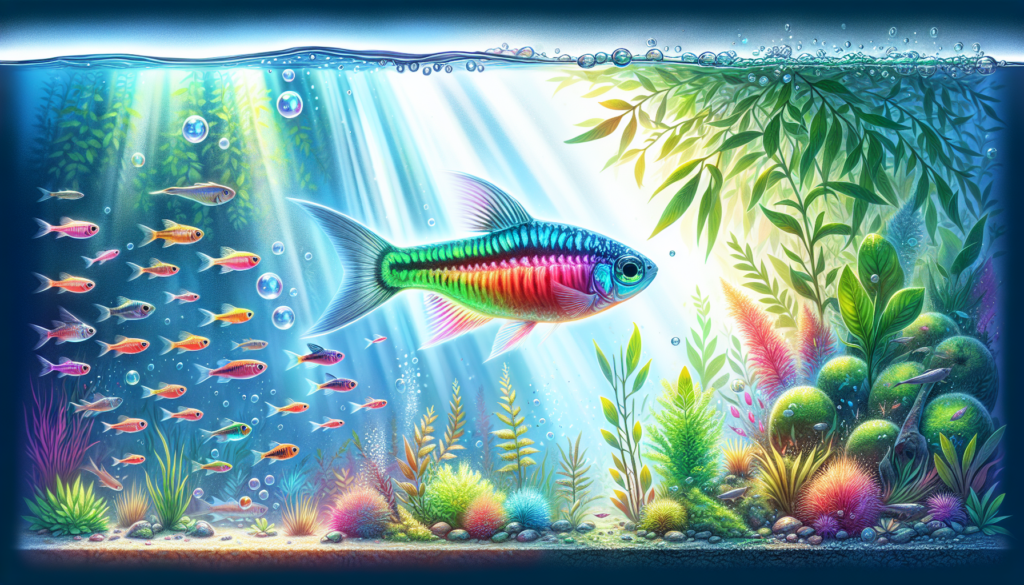Neon tetras, those vibrant little fish that bring life and color to any aquarium, have always fascinated fish enthusiasts. If you have ever wondered just how big these tiny creatures can grow, you are in for an intriguing surprise. Neon tetras may be small in stature, but they have a remarkable ability to reach sizes that will leave you amazed. In this article, we will explore the growth size of neon tetras, delving into the factors that influence their size and providing insights into what to expect when welcoming these captivating fish into your aquatic world. Get ready to be enthralled by the extraordinary growth potential of neon tetras!
Physical Appearance of Neon Tetras
Coloration
Neon tetras are known for their vibrant and eye-catching coloration. Their bodies are adorned with a distinctive electric blue stripe that runs horizontally from their nose to their tail, creating a striking contrast against their iridescent silver color. The vibrant blue stripe serves as a visual marker that makes neon tetras easily recognizable in both the wild and captivity.
Body Shape
Neon tetras have a streamlined body shape, which allows them to move swiftly through the water. Their compressed body is elongated and features a slightly rounded belly. This slender physique enables them to navigate through dense vegetation and shoal together seamlessly, creating a stunning visual display for aquarium enthusiasts.
Size
In terms of size, neon tetras are relatively small freshwater fish. On average, they usually grow to be around 1 to 1.5 inches in length. Their petite stature makes them a popular choice for community aquariums, as they can comfortably coexist with various other fish species without overwhelming the tank.
Factors Influencing the Growth Size
Water Quality
Proper water quality is crucial for the growth and overall health of neon tetras. Maintaining optimal water parameters, such as neutral pH levels (around 6.8 to 7.5), can greatly contribute to their growth rate. Additionally, regular water changes and the removal of harmful substances like chlorine and heavy metals are essential to ensure a conducive environment for their development.
Tank Size
The size of the tank plays a vital role in the growth of neon tetras. Inadequate tank size can restrict their movement and impede their growth potential. A spacious tank with a minimum capacity of 10 gallons is recommended for a small school of neon tetras. Providing them with ample swimming space allows them to exercise and thrive, resulting in better growth rates.
Temperature
Maintaining an appropriate temperature range is crucial for the growth of neon tetras. These tropical fish thrive in temperatures between 72°F and 78°F (22°C and 26°C). Consistently providing them with the ideal temperature promotes optimal growth and ensures their overall well-being.
Feeding
Neon tetras are omnivores and require a balanced diet to support their growth. Feeding them a variety of high-quality flake or pellet food, supplemented with live or frozen foods such as brine shrimp or bloodworms, helps fulfill their nutritional requirements. Regular feeding in small portions throughout the day ensures their growth potential is maximized.
Genetics
Genetics also play a role in the growth size of neon tetras. Selective breeding practices can result in variations in size and growth rates among different strains and varieties of neon tetras. When choosing neon tetras for your aquarium, it is essential to consider their genetic background and opt for healthy specimens with desirable growth potential.

Optimal Water Quality for Growth
pH Level
Maintaining a suitable pH level is critical for the growth of neon tetras. A pH range between 6.8 and 7.5 is considered optimal for their development. It is important to monitor and adjust the pH levels accordingly to ensure their well-being and promote healthy growth.
Temperature Range
Neon tetras thrive in tropical environments, requiring a consistent temperature range between 72°F and 78°F (22°C and 26°C). Fluctuations in temperature can negatively impact their growth and overall health. Using a reliable aquarium heater and thermometer can help maintain the desired temperature range.
Ammonia and Nitrite Levels
Ammonia and nitrite levels must be kept at zero or as close to zero as possible. These toxic substances can be detrimental to neon tetras’ growth and can lead to various health issues. Regular water testing and proper filtration systems are essential to ensure a clean and safe environment for their growth.
Hardness
The hardness of the water, specifically the general and carbonate hardness, can affect the growth of neon tetras. They prefer slightly acidic to neutral water with moderate hardness levels. The optimal range for general hardness (GH) is between 4 and 8 dGH, while carbonate hardness (KH) should be maintained between 3 and 10 dKH.
Dissolved Oxygen
Adequate oxygen levels are vital for neon tetras’ growth and overall well-being. Ensuring sufficient water circulation and aeration in the aquarium helps maintain optimal dissolved oxygen levels. Live plants can also contribute to oxygen production and create a more natural and conducive environment for their growth.
Importance of Tank Size
Tank Capacity
Providing neon tetras with an appropriately sized tank is crucial for their growth and overall happiness. A minimum tank capacity of 10 gallons is recommended for a small school of neon tetras. This allows them to have sufficient space to swim and explore, promoting their physical development.
Adequate Swimming Space
Neon tetras are active swimmers that require ample space to exercise and showcase their natural shoaling behavior. A spacious tank allows them to swim freely, stimulating their muscles and promoting their growth. It is important to consider not only the length and width of the tank but also its height to accommodate their vertical movement habits.
Water Volume and Dilution
A larger water volume in the tank helps dilute waste products produced by neon tetras, ensuring better water quality. High water volume reduces the concentration of toxins such as ammonia and nitrites, minimizing their negative effects on growth. It also provides a more stable environment, which is beneficial for overall health and development.
Behavioral Considerations
Tank size is not only important for physical growth but also for supporting the natural behaviors of neon tetras. Inadequate tank size can lead to stress and behavioral issues, hindering their growth potential. By providing them with a spacious and well-designed environment, you can create a stress-free and stimulating habitat that promotes their growth.

Temperature Requirements for Growth
Normal Range
Neon tetras are native to warm tropical regions, and their growth is optimized within a specific temperature range. The normal temperature range for neon tetras falls between 72°F and 78°F (22°C and 26°C). Maintaining a consistent and suitable temperature promotes their metabolic processes, supporting healthy growth and development.
Effect of Extreme Temperatures
Extreme temperatures, either too high or too low, can be detrimental to the growth of neon tetras. High temperatures can lead to increased metabolic rates, potentially resulting in stunted growth and reduced lifespan. On the other hand, lower temperatures can slow down their metabolic processes, impacting growth and overall vitality. Maintaining a stable and appropriate temperature range is vital for their optimal growth.
Seasonal Variations
Temperature fluctuations occur naturally in different seasons, and neon tetras are adapted to some degree of variability. However, sudden or drastic temperature changes can be stressful for these tropical fish and hinder their growth. It is crucial to monitor and adjust the temperature accordingly, providing a stable and controlled environment throughout the seasons to support their growth potential.
Feeding Habits of Neon Tetras
Diet in the Wild
In their natural habitat, neon tetras primarily feed on small invertebrates, including insect larvae and tiny crustaceans. They have a preference for live foods due to their high protein content, which supports their growth and development. They also consume plant matter from algae and aquatic vegetation, providing essential nutrients and fiber.
Diet in Captivity
In captivity, neon tetras can adapt to a varied diet that includes high-quality flake or pellet food specially formulated for tropical fish. These commercial foods provide a balanced mix of proteins, fats, vitamins, and minerals necessary for their growth. However, it is also important to supplement their diet with live or frozen foods such as brine shrimp, bloodworms, or daphnia to mimic their natural feeding habits and provide additional nutrients.
Feeding Frequency
Neon tetras have small stomachs and should be fed small portions multiple times a day. Offering them small meals 2 to 3 times a day ensures they receive a steady supply of nutrients without overfeeding or causing waste buildup. It is important to observe their feeding behavior and adjust the feeding frequency accordingly to maintain optimal growth.
Variety in Diet
Incorporating a variety of foods into neon tetras’ diet is beneficial for their growth and overall health. Alongside commercial flakes or pellets, providing them with occasional live or frozen foods helps stimulate their natural foraging behavior, boosts their nutrient intake, and can enhance their growth rates. Offering a diverse diet ensures they receive a balanced nutrition profile, supporting their development.
Role of Genetics in Growth
Inbreeding and Growth Potential
Selective breeding practices can influence the growth potential of neon tetras. However, excessive inbreeding to achieve desired traits can lead to negative genetic consequences, including reduced growth rates and overall vitality. It is crucial to source neon tetras from reputable breeders who prioritize genetic diversity and maintain healthy breeding practices.
Alternate Strains and Varieties
Neon tetras come in different strains and varieties, each with its own growth potential and characteristics. Some strains may exhibit faster growth rates or have variations in coloration. When selecting neon tetras for your aquarium, considering alternative strains may provide options for specific growth preferences or aesthetic appeal. It is essential to research and understand the unique characteristics of different strains to choose the best fit for your tank.
Factors Hindering Growth
Poor Water Quality
Inadequate water quality, characterized by high levels of ammonia, nitrites, or other toxins, can significantly hinder the growth of neon tetras. Poor water conditions stress the fish and compromise their immune system, making them more susceptible to diseases and stunting their growth. Implementing regular water testing, proper filtration, and regular water changes are essential to maintain optimal water quality.
Overcrowding
Overcrowding can limit the growth potential of neon tetras. When sharing limited space with an excessive number of tank mates, competition for resources such as food and swimming space increases. This can restrict their movement and access to essential nutrients, resulting in slower growth. Providing adequate space and carefully managing the number of fish in the tank is crucial for promoting optimal growth.
Insufficient Nutrition
A poor or imbalanced diet can hinder the growth of neon tetras. Inadequate protein, vitamins, or minerals in their diet can lead to stunted growth and a weakened immune system. It is important to ensure a balanced and varied diet that meets their nutritional requirements. Adding live or frozen foods as supplementary feeding can enhance their nutrient intake and promote growth.
Presence of Diseases
Diseases, such as bacterial or parasitic infections, can significantly affect the growth and overall health of neon tetras. Infected fish may experience appetite loss, decreased activity, and deteriorating condition, leading to reduced growth rates. Quarantining new fish, maintaining proper hygiene, and observing any signs of illness are crucial to preventing diseases and ensuring optimal growth.
Ideal Growth Rates
Normal Growth Expectations
Neon tetras typically exhibit a moderate growth rate. Under optimal conditions, they can grow to reach their full adult size of around 1 to 1.5 inches within a few months. It is important to note that individual growth rates may vary, influenced by environmental factors, genetics, and overall health. Monitoring their growth progress and providing ideal conditions can help maximize their growth potential.
Growth Comparison to Other Species
Compared to some larger fish species, neon tetras have a relatively slower growth rate. Their compact size and limited lifespan restrict their growth potential in comparison to species that have longer lifespans and larger body sizes. However, their vibrant coloration and active nature make them highly sought-after in the aquarium hobby, regardless of their smaller size.
Conclusion
The growth size of neon tetras is influenced by various factors, including water quality, tank size, temperature, feeding habits, and genetics. Optimal water quality, with appropriate pH levels, temperature, and dissolved oxygen, is crucial for supporting their growth. Providing a tank with sufficient space and appropriate swimming areas ensures their physical development and reduces stress. Feeding them a balanced and varied diet, considering genetics, and preventing hindrances such as poor water quality or diseases all contribute to their growth potential. Neon tetras may not grow as large as some other species, but their vibrant coloration and active nature make them a captivating addition to any aquarium.
